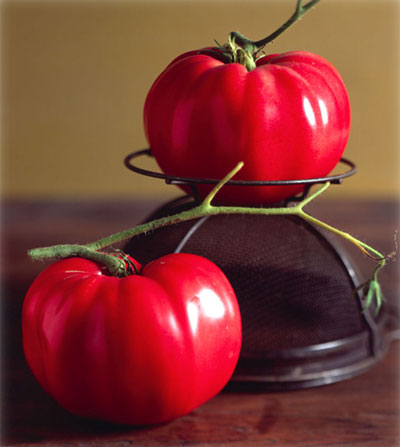|
|
|
Decorah, Iowa from SeedSavers Website
Photograph by Victor Schrager, from The Heirloom Tomato
by
Amy Goldman.
Seed Savers Exchange, Inc., a leading
non-profit organization dedicated to saving and sharing heirloom seeds, has
announced that a third deposit of heirloom seeds has been deposited safely
into the
Svalbard Global Seed Vault in Norway.
Here is a small sampling of the varieties in the most recent deposit:
The German Pink Tomato was brought to America in 1883 by his maternal Great-Great Grandparents Michael Ott and Margaret Ertle from Dreuschendorf, Germany, and has been grown every summer by the family.
In fact, German Pink was one of the two original varieties
that inspired the founding of Seed Savers Exchange in 1975 by his parents.
Members of the Seed Savers Exchange can gain access to the same seeds deposited in Svalbard through the annual 500-page Yearbook that is distributed to SSE's 12,500 members.
The Yearbook - listing 13,263 unique varieties -
serves as a networking tool linking members in sharing varieties with one
another. Over the past 35 years, members have shared hundreds of thousands
of varieties.
The Svalbard Global Seed Vault offers protection against permanent loss due to natural disasters, wars, equipment failures, accidents, and loss of funding that can plague even the best gene banks. As a service to the world community, the Government of Norway paid for completing the Svalbard Global Seed Vault's construction.
The Global Crop Diversity Trust and the Government of Norway are financing its operating costs.
The Svalbard Global Seed Vault is managed
by the Nordic Gene Bank (NordGen)
under a tripartite agreement between the Government of Norway, the Global
Crop Diversity Trust, and NordGen. Storage of seed in the Svalbard Global
Seed Vault is free of charge.
At this temperature, seeds can be stored safely for decades - even if the earth warms or power goes out. The Svalbard Global Seed Vault has the capacity to store 4.5 million different seed samples (each sample containing about 500 seeds) potentially from 1,400 gene banks in more than 100 countries.
The Seed Vault will soon house and secure the world's largest collection of seeds, including many varieties no longer grown by farmers or gardeners.
|


